Abstract
Fluorine-containing functional groups are important motifs influencing physical and biological properties of organic compounds. Visible-light photoredox catalysis as a powerful strategy for the activation of small molecules contributed significantly to the rapid progress of new synthetic procedures allowing introduction of fluorine atoms into organic substrates. In this review, we highlight the distinct strategies for transition metal- and organic-photocatalytic fluorination of arenes and heteroarenes by a broad range of fluorinating compounds. The presented procedures are divided into two groups. The first group involves the reactions enabling a direct attachment of CF3-, CnFm-, F-, CF3O-, CF3S-, and SO2F- substituents to various aromatic compounds. The second group presents the tandem reactions where the formation of the aromatic system occurs after installation of the fluorine-containing group on the non-aromatic fragment of the molecule.
1. Introduction
Fluorination reactions have gained a prominent role among late-stage synthetic strategies due to the influence of fluorine atom substitution on organic compounds. Introduction of fluoroalkyl groups into organic substrates is an important transformation on account of the changes that these groups bring to molecules, such as an increase in lipophilicity, resistance to oxidation, bioavailability, increase in bioactivity, water repellent properties, metabolic stability, etc. [1,2,3,4,5,6,7,8,9]. Utilization of perfluoroalkylated molecules in material and catalytic chemistry is unprecedented [10,11,12,13,14]. Visible-light photoredox catalysis has become a prominent sector of synthetic methodology in the last several years due to its mild nature, its high functional group compatibility, and the unique mechanistic approaches it enables [15,16,17,18,19,20,21,22]. This method has become an important approach toward the catalytic fluorination of organic molecules. Some reviews support the utility and versatility of the photocatalytic reactions in the synthesis of complex fluorinated compounds [23,24,25,26,27,28,29]. Recently, the study of the introduction of fluorine-containing groups into aromatic or heteroaromatic substrates has accelerated, as evidenced by the large volume of papers published in recent years [30,31,32,33]. Remarkably, there is no current review available dedicated solely to photoinduced fluorination of aromatic compounds. This review will encompass the reactions involving the use of various fluorine-containing reactants in photocatalytic formation of fluorinated aromatic compounds in the timeframe of 2011–2022. The emphasis will be put on both synthetic outcome and reaction mechanism. This review is divided into two parts. In the first part, the photocatalytic reactions are presented involving the installation of the fluorine-containing moiety directly onto the aromatic ring. The second section involves formation of the aromatic ring after photocatalytic installation of the fluorine-containing group onto the molecule. This review does not involve photocatalytic difluoroalkylation of aromatic compounds as it has already been included in another paper [34].
2. Trifluoromethylation of Arenes
2.1. CF3SO2Cl as the Fluorinating Reactant
The CF3 group enjoys a privileged role in the realm of medicinal chemistry because it can influence chemical and metabolic stability, lipophilicity, and binding selectivity [35,36]. Although common pharmacophores often bear CF3 motifs in an aromatic system, access to such analogues typically requires the incorporation of the CF3 group at the start of a multi-step synthetic sequence. Thus, there has been considerable interest in development of new methodologies for highly efficient and selective incorporation of a CF3 group into aromatic molecules. The first efficient protocol for the photocatalytic trifluoromethylation of arenes was developed by the MacMillan group (Scheme 1) [37].
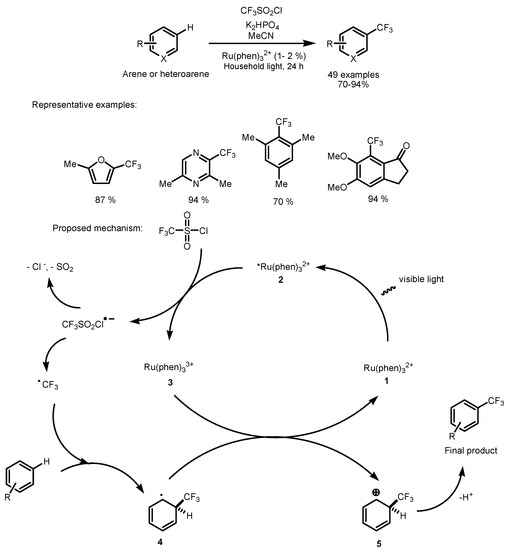
Scheme 1.
Visible-light-driven Ru-catalyzed trifluoromethylation of arenes with CF3SO2Cl.
The operationally simple strategy involved the use of CF3SO2Cl E[A/A−1] = (−0.18 V vs. SCE) as the fluorinating agent in the presence of commercial photocatalyst [Ru(phen)3]Cl2 E[*A/A−1] = (−0.9 V vs. SCE) and a household light bulb. The authors demonstrated the broad utility of this transformation through addition of •CF3 to a number of heteroaromatic and aromatic systems. In the proposed mechanism, the reaction starts with excitation of 1 followed by reduction of CF3SO2Cl by the excited *[Ru(phen)3]Cl2 2. The obtained CF3SO2Cl radical anion collapses to generate •CF3 in an entropically driven process by the release of SO2 and Cl¯. The electron-deficient •CF3 is added to the most electron-rich position of arene. The resultant cyclohexadienyl radical 4 (in the case of benzene E[A/A−1] = (−0.1 V vs. SCE)) undergoes oxidation by [Ru(phen)3]3+ E[A/A−1] = (1.31 V vs. SCE) 3 affording the respective carbocation 5 and regenerating ground-state photocatalyst. Finally, deprotonation of the cyclohexadienyl cation 5 with a suitable base provides the desired trifluoromethylated arene. The authors stress that a major benefit of the mild, visible-light-induced trifluoromethylation procedure is its amenability to late-stage synthetic trifluoromethylation of aromatic and heteroaromatic systems without the need for aryl ring pre-activation. The authors observed that trifluoromethylation of electronically deficient halide-substituted heteroaromatics (such as 2,6-dichloropyrazine) was also operative. Unsubstituted analogues of each of these heterocycles can also be trifluoromethylated, albeit with somewhat diminished efficiency. To demonstrate the applicability of the method, biologically active molecules as e.a. DNA-base uracil analogue, vitamin P, or Alzheimer’s drug precursor were efficiently fluorinated.
CF3SO2Cl was also used as fluorinating reactant for the selective trifluoromethylation of four different π-conjugated arenes to afford mono(trifluoromethylated) arenes in good yield (Scheme 2) [38].

Scheme 2.
Visible-light-driven Co-catalyzed trifluoromethylation of polycyclic aromatic hydrocarbons with CF3SO2Cl.
The reaction requires the use of luminescent Co(III) complexes 6 or 7 as photocatalysts which are powerful photo-oxidants E[*A/A−1] = (2.26 V and 2.75 V vs. SCE). A plausible reaction mechanism involves excitation of pyrene to its triplet state 8 by means of energy transfer from the excited photocatalyst 6*. Oxidative quenching via single-electron transfer of CF3SO2Cl affords •CF3 with concomitant formation of the pyrenyl radical cation 9. The electron-deficient •CF3 is added to the most electron-rich position of pyrene. The resultant CF3-pyrenyl radical 10 then undergoes oxidation by the excited photocatalyst 6*, to generate the CF3-pyrenyl cation 11. The two photocatalytic cycles are closed via a single electron transfer where 9 is reduced to pyrene and the reduced photocatalyst [ML2]2+ is oxidized to 6. Finally, facile deprotonation of 11 with K2HPO4 affords the desired CF3-pyrene. A new photoredox system in which a photoreductive activation of CF3SO2Cl was achieved has been developed by Blechert and coworkers (Scheme 3) [39]. In this work, heterogeneous, mesoporous graphitic carbon nitride (mpg-CN), a metal-free solid-state organocatalyst with an oxidation potential E[A/A−1] = (1.3 V and 1.4 V vs. SHE, pH 7), was able to reduce CF3SO2Cl, affording •CF3. With the developed method, it was possible to trifluoromethylate benzene and a great variety of heteroaromatic compounds such as pyrroles, oxazoles, furanes, thiophenes, indoles, and pyrazines in moderate to excellent yields. A variety of functional groups were tolerated, including aldehydes, esters, halides, and amides. However, the reaction suffers from double trifluoromethylation and formation of chlorinated side products.
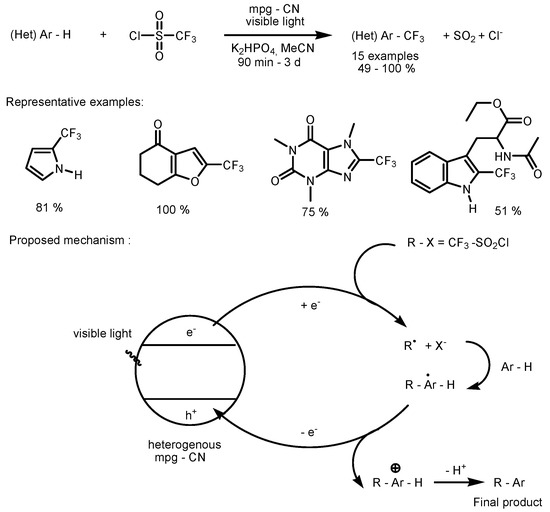
Scheme 3.
Photocatalytic generation of alkyl radicals for trifluoromethylation of arenes using CF3SO2Cl and mpg-CN.
Diaz and coworkers revealed that trifluoromethylation reactions can be successfully carried out in gel media under aerobic conditions, affording the desired products in comparable yields to those obtained in homogeneous solution (Scheme 4) [40]. A series of electron-rich 5-membered heteroarenes and electron-deficient 6-membered heteroarenes were trifluoromethylated in the presence of Ir(Fppy)3 or Ru(phe)3Cl2 as the photocatalyst, CF3SO2Cl as the fluorinating reactant, and gelator under aerated conditions. The yields were comparable to those obtained in solution under an inert atmosphere. The further study revealed that, when the same reaction proceeded in solution in the presence of gelator at a concentration marginally below the critical gelation concentration (CGC), the final obtained product yields were ∼10−15% lower compared to the reaction carried out in gel phase at a concentration above the CGC. This effect was explained on the basis of the oxygen-blocking efficiency achieved with the gel network. The authors stress that gel media seem to be a promising candidate to facilitate photochemical reactions under aerobic conditions, outcompeting the MacMillan procedure requiring a strict inert oxygen-free atmosphere.
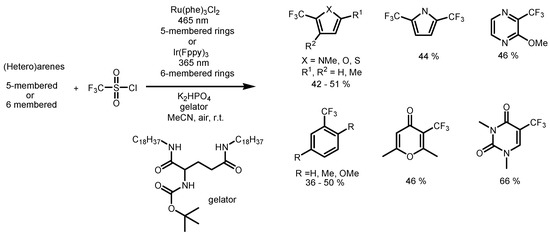
Scheme 4.
Photocatalytic trifluoromethylation of (hetero)arenes in gel media.
2.2. CF3I as the Fluorinating Reactant
CF3 radicals can be generated under mild, neutral conditions from commercially available and relatively inexpensive CF3I Eox[A/A−1] = (−1.52 V vs. SCE) [41,42,43,44,45,46,47]. However, the gaseous state of CF3I makes it hard to handle, causing difficulties in knowing the exact concentration present in the reaction mixture. Ye and coworkers have reported the trifluoromethylation of arylboronic acids by applying their strategy of merging photoredox catalysis with transition metal catalysis (Scheme 5) [48]. The combination of the Cu/Ru dual catalytic system has enabled the trifluoromethylation of a wide variety of aromatic and heteroaromatic substrates bearing many common functional groups. According to the presented mechanism, CF3I is reduced by the reduced photocatalyst [Ru(bpy)3]Cl2 12 with formation of •CF3 13. Addition of •CF3 to the copper(II) species 15 formed in the photocatalytic cycle from the Cu(I) salt 14 oxidizes the metal to give the high-valent trifluoromethyl−copper(III) species 16. Transmetalation of arylboronic acid 17 to give aryl−copper(III) intermediate 18 is followed by aryl-CF3 bond-forming reductive elimination to give the final product and regenerate the copper(I) species 14.
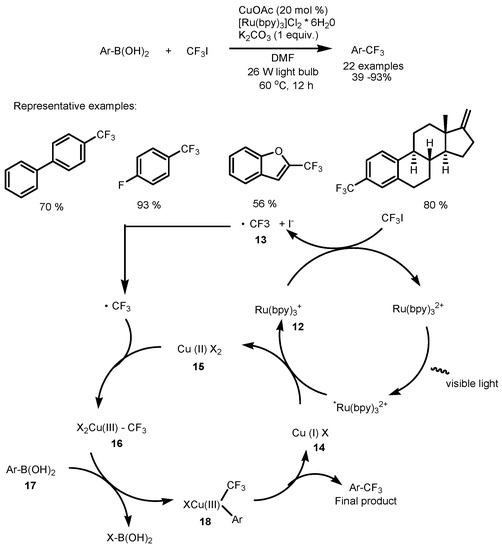
Scheme 5.
Visible-light-driven trifluoromethylation of arylboronic using CF3I and Ru/Cu dual catalytic system.
The interesting extention of this work reported by the Ritter group involves a site-selective late-stage introduction of trifluoromethyl groups into arenes using Cu-CF3 as the radical source (Scheme 6) [49]. The Cu-CF3 reagent was obtained by mixing CuSCN, CsF, and TMSCF3 at 23 °C in DMF prior to addition of the Ru(II) catalyst and thiantrenium salt. The two-step procedure entails exquisitely selective thianthrenation followed by chemoselective photoredox-mediated trifluoromethylation of the aryl thianthrenium salts. The reaction proceeds with broad functional group tolerance, even for complex small molecules on the gram scale. The proposed mechanism involves oxidation of Cu(I)-CF3 19 by the excited Ru(II) 20, affording Cu(II)-CF3 21, which is followed by oxidative addition of the aryl radical 22 forming the aryl−copper(III) intermediate 23. The aryl radicals 22 are formed upon C-S bond fragmentation of the reduced thianthrenium salt 25 which is obtained in the photocatalytic cycle via single-electron transfer from Ru(I) 26 to 24. The aryl-CF3 bond-forming reductive elimination of 23 gives the final product. However, the additional experiments performed by the authors involving a Stern–Volmer analysis and trapping of radicals by TEMPO suggest that the reaction occurs not only via a CF3 radical pathway. Recently, Cho and coworkers reported the trifluoromethylation of electron-rich heterocycles with Ru(bpy)3Cl2 as the photosensitizer and CF3I as the CF3 radical source (Scheme 7) [50].
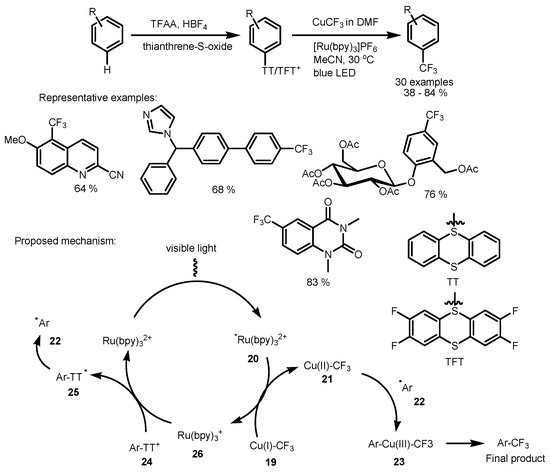
Scheme 6.
Visible-light-driven Ru-catalyzed trifluoromethylation of aryl-thianthrenium salts using Cu-CF3 reactant.

Scheme 7.
Visible-light-driven Ru-catalyzed trifluoromethylation of electron rich heteroaromatic compounds using CF3I.
A variety of aromatic compounds were transformed into trifluoromethylated products under mild reaction conditions. In the proposed mechanism, Ru(bpy)32+ 27 is excited by visible light, providing *Ru(bpy)32+ 28 that is then reductively quenched by an amine to produce Ru(bpy)3+ 29 and the ammonium radical cation 30. The Ru(bpy)3+ species 29 in turn performs a single-electron reduction of the F3C-I bond, regenerating 27 and forming a carbon-centered •CF3. Finally, coupling of this electron-deficient radical with an electron-rich heterocycle 31 and the oxidation of the resulting radical 32 to 33 followed by rearomatization gives the trifluoromethylated product. The Fukuzumi group reported the use of cyclometalated platinum(II) complexes as photocatalyst for trifluoromethylation reactions (Scheme 8) [51].
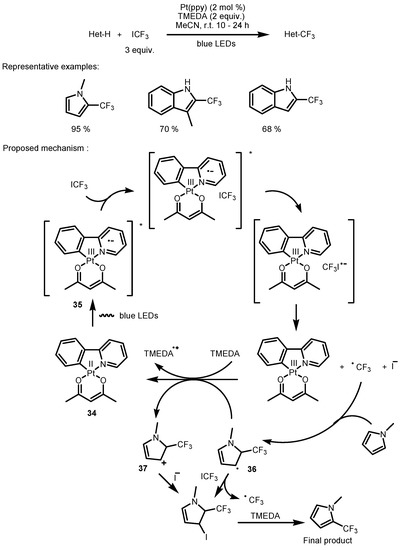
Scheme 8.
Visible-light-driven Pt-catalyzed direct trifluoromethylation of heteroarenes with trifluoromethyl iodide.
A series of indoles and pyrroles were trifluoromethylated in good to excellent yields upon reaction with N,N,N’,N’-tetramethylethylenediamine as an electron donor and CF3I. According to the proposed mechanism, photoexcitation of the platinum(II) catalyst 34 would promote an electronic transition to a singlet MLCT state which would undergo fast intersystem crossing to a triplet MLCT state 35. Reaction between this triplet state and trifluoromethyl iodide affords the CF3 radical that can be added to heteroaromatic substrates to give the desired aryl radical 36. The final product can be formed by oxidation of 36 to 37 followed by addition of I¯ and dehydrohalogenation with amine. The alternative pathway involves iodination of 36 with CF3I via a chain propagation mechanism followed by dehydrohalogenation with amine. Reductive regeneration of the platinum(II) in the presence of a sacrificial electron donor 36 or amine would then close the catalytic cycle.
2.3. Hypervalent Iodine and Sulfur Compounds as the Fluorinating Reactants
Hypervalent iodine(III) reagents are widely used in organic synthesis, because of their low toxicity, strong electrophilicity, and valuable oxidizing properties [52,53,54,55,56]. The Scaiano group decided to employ electrophilic CF3 reagents, such as Togni hypervalent-iodine compounds, for the trifluoromethylation of electron-rich heterocycles. Using methyl blue (MB) as a photocatalyst and TMEDA as the sacrificial reductant, trifluoromethylation of electron-rich heterocycles was demonstrated, which proceeded in moderate to good yield (Scheme 9) [57].

Scheme 9.
Visible-light-driven trifluoromethylation of heteroaromatic compounds using methyl blue as a photocatalyst and Togni reagent.
A possible mechanism for the catalytic formation of •CF3 involves formation of the triplet state of MB 38 upon visible light irradiation. The excited photocatalyst can be quenched by amine (TMEDA) to form the semireduced MB radical 39 and an α-amino radical 40. Both of these species can in turn reduce Togni reagent 41, resulting in the release of a •CF3 which is added next to the aromatic molecule, affording the final product. At the same time, Ma and coworkers developed the first visible-light-induced Ir-catalyzed radical trifluoromethylation of free anilines with Togni reagent at room temperature (Scheme 10) [58]. A variety of aniline derivatives have been tested and high functional group tolerance was observed, indicating that the method can be used for the late incorporation of a CF3 group into an aniline moiety. According to the mechanism, single-electron transfer from the excited photocatalyst 42 to Togni reagent 43 generates a strong oxidant 44 and 45 which would then collapse to •CF3 46. The obtained 46 is added to the most electron-rich position of aniline derivative to form the radical 47. Subsequently, the cation species 48 is formed upon oxidation with strong oxidant 44. Finally, deprotonation of 48 could afford the final product.

Scheme 10.
Visible-light-driven trifluoromethylation of aniline derivatives using Ir(ppy)3 as a photocatalyst and Togni reagent.
In the search for new trifluoromethylation reactions with inexpensive and easily handled •CF3 sources, the Quing group developed a practical visible-light-induced decarboxylative trifluoromethylation of (hetero)arenes using the easily accessible [bis(trifluoroacetoxy)iodo]perfluorobenzene as the trifluoromethylating reagent (Scheme 11) [59]. This method proved to be tolerant of various (hetero)arenes and functional groups, however, in some cases, the trifluoromethylated products were obtained as a mixture of isomers. Meanwhile, electron-deficient heteroarenes (pyridines, pyrimidines, pyrazines, and thiazoles) were also amenable to the reaction. The plausible reaction mechanism involves oxidation of *Ru(bpy)32+ E[*A/A−1] = (−0.81 V vs. SCE) by 49 E[A/A−1] = (−0.08 V vs. SCE), affording the iodanyl radical 50. The Stern−Volmer fluorescence quenching studies confirmed that 49 could quench *Ru(bpy)32+ effectively. Subsequently, intermediate 50 undergoes a homolytic scission of the I−O bond to generate pentafluoroiodobenzene and a trifluoroacetoxy radical 51. The resulting radical 51 extrudes CO2 to generate the •CF3, which is then added to the arene 52 for the formation of intermediate 53. Radical 53 might be oxidized by Ru(bpy)33+ (path A) and/or 49 (path B) to afford the corresponding cation 54. Finally, intermediate 54 undergoes deprotonation to give the desired product. It is noteworthy that pentafluoroiodobenzene can be recycled and could be used for the preparation of 49.
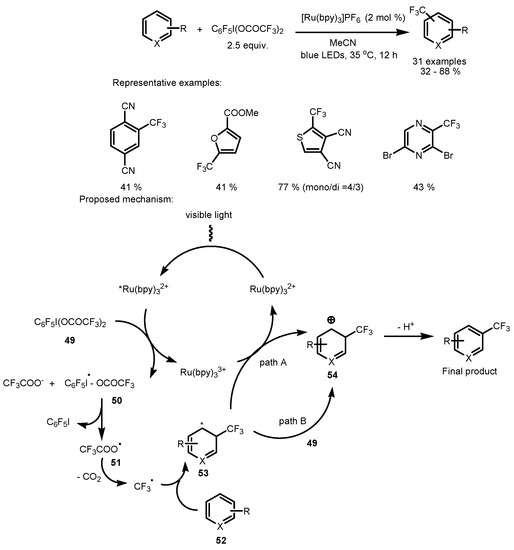
Scheme 11.
Visible-light-driven Ru-catalyzed decarboxylation of perfluorophenyl iodine(III) trifluoroacetate for C-H trifluoromethylation of heteroaromatic compounds.
The commercially available dimesithylsulfoniumtrimethyl trifluoromethanesulfonate (dMesCF3) was applied as the •CF3 source to a trifluoromethylation of aryl bromides through dual copper-photoredox catalysis (Scheme 12) [60]. The mechanism is similar to that presented in Scheme 4, however, Ir(dFFppy)2(4,4′-dCF3bpy)PF6 E[*A/A−1] = (+1.55 V vs. SCE) was used as photocatalyst. During the reaction, •CF3 is generated by reduction of dMesCF3 55 in the photocatalytic cycle. Noteworthily, tris-(trimethylsilyl) silanol 56 E[A/A−1] = 1.54 V is oxidized in the photocatalytic cycle to afford after the rearrangement the silyl radical 57 which is then engaged in the bromine atom abstraction, affording the respective aryl radical 58. The oxidative addition of •CF3 to the Cu(I) species 59 gives the Cu(II) intermediate 60 and, followed by the oxidative addition of the aryl radical 58, affords the respective Cu(III) adduct 61. Reductive elimination from this high-valent Cu(III) intermediate yields the desired product and simultaneously regenerates Cu(I) catalyst 59. A broad range of electronically differentiated parasubstituted bromoarenes including fused cyclic motifs were found to give good to excellent yields of the desired products. Regarding the scope of heteroarylbromides, pyridine derivatives as well as bromopyrazines, pyrimidines, and pyridazines or five-membered heteroarylbromides, such as imidazoles, pyrazoles, and thiazoles, were competent substrates, providing the desired products in good yields.

Scheme 12.
Visible-light-driven trifluoromethylation of arenes using dimesithylsulfoniumtrimethyl trifluoromethanesulfonate in the Ir/Cu dual catalytic system.
2.4. Trifluoromethyl Acid and Anhydride as the Fluorinating Reactants
Trifluoroacetic acid and its anhydride (TFAA) are desirable •CF3 sources from the perspective of availability and cost, but have traditionally proven challenging to utilize because of the high oxidation potential E[A/A−1] > 2.4 V of the CF3COO− anion formed during reaction. Stephenson reported a strategy for the use of trifluoroacetic anhydride for a scalable and operationally simple trifluoromethylation reaction using pyridine N-oxide and photoredox catalysis to affect a facile decarboxylation to •CF3 (Scheme 13) [61]. Pyridine N-oxide was identified as the reagent of choice for the formation of a reducible TFAA adduct E[A/A−1] = (−1.10 V vs. SCE). The reagent combination is effective in equal stoichiometry with respect to the substrate, and is sufficiently inexpensive for large-scale implementation. Furthermore, following cleavage of the weak N–O bond and CO2 extrusion, the generation of pyridine as a byproduct is a highly beneficial design feature, preventing the need for exogenous base. Using this methodology, trifluoromethylation of vinyl, aryl, and heteroaryl substrates was performed in acetonitrile, with 1–2 equivalents of pyridine N-oxide providing generally optimal results. In some cases, however, Friedel–Crafts, N-, and O-acylation with trifluoroacetic anhydride was also observed. Importantly, the reaction was found to be tolerant of air and moisture. The same group later reported the use of 4-phenylpyridine N-oxide as a redox trigger which improved the trifluoromethylation yields and allowed a kilogram scale-up in a flow reactor [62]. The trifluoromethylation protocol developed by the Jin group is worth noting (Scheme 14). The reaction requires the use of trifluoroacetic acid in the presence of ruthenium catalyst and diaryl sulfoxides. Various heteroarenes were successfully trifluoromethylated, however, the exact role of diarylsulfoxides in the reaction mechanism is unclear [63].
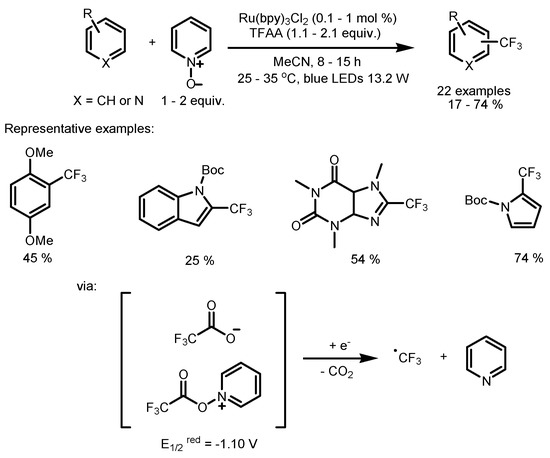
Scheme 13.
Visible-light-driven Ru-catalyzed trifluoromethylation of arenes using acetic acid anhydride.
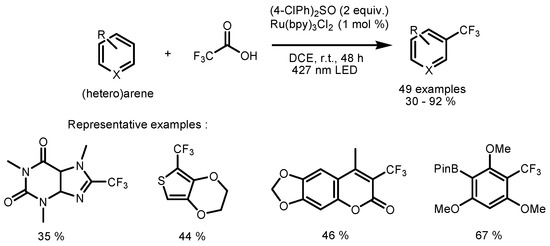
Scheme 14.
Visible-light-driven Ru-catalyzed trifluoromethylation of arenes using trifluoroacetic acid and diarylsulfoxide.
2.5. Sodium Triflinate as the Fluorinating Reactant
Sodium triflinate CF3SO2Na (Langlois reagent) can be regarded as an easy-to-handle, inexpensive, and solid trifluoromethylating agent, capable of generating CF3 radicals in the presence of a strong oxidant (e.g., t-BuOOH) [64,65]. The Itoh group reported the visible-light-induced trifluoromethylation of arenes and heteroarenes using CF3SO2Na catalyzed by anthraquinone-2-carboxylic acid AQN (Scheme 15) [66].

Scheme 15.
Visible-light-driven AQN-catalyzed trifluoromethylation of heteroaromatic compounds using sodium triflinate.
According to the proposed mechanism, the triflinate anion 62 E[A/A−1] = (+0.6 V vs. SCE) is oxidized to 63 by the excited photocatalyst 64 E[A/A−1] > (+1.5 V vs. SCE). The obtained 63 decomposes, affording •CF3 and SO2. The radical addition of •CF3 to an electron-rich position of the aromatic ring, followed by oxidation of the generated radical 65 to cation 66 by •CF3 and the concomitant deprotonation, afforded the final product. The easy oxidation of the reduced photocatalyst 67 E[A/A−1] = (−1.3 V vs. SCE) by SO2 E[A/A−1] = (−1.1 V vs. SCE) produced by cleavage of 63 regenerates the ground state of the photocatalyst. Alcazar and coworkers reported a continuous-flow protocol for the trifluoromethylation of arenes, heteroarenes, and benzofused heterocycles relying on the use of solid CF3SO2Na as the trifluoromethylating agent, the iridium complex [Ir{dF(CF3)ppy}2](dtbpy)]PF6 as the photoredox catalyst, and (NH4)2S2O8 as the external oxidant (Scheme 16) [67].
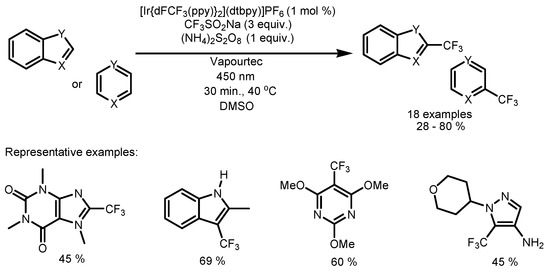
Scheme 16.
Visible-light-driven Ir-catalyzed trifluoromethylation of heteroaromatic compounds using sodium triflinate.
This methodology enabled trifluoromethylation of caffeine, indoles, benzimidazoles, pyridines, pyridones, pyrazoles, and unactivated arene substrates in moderate to excellent yields within only 30 min of reaction time. The main reason for the remarkable acceleration of the reaction rate lies in the improved irradiation of the reaction mixture obtained in the microflow reactor (Vapourtec). The luminescence quenching studies performed by the authors suggest that the excited state of the photocatalysts E[*A/A−1] = (1.21 V vs. SCE) can be reductively quenched by the Langlois reagent E[A/A−1] = (+1.02 V vs. SCE), thus generating •CF3.
The Ackermann group developed the first electrophotochemical trifluoromethylation enabled by the cooperative action of electrochemistry and photochemistry in the presence of [Mes-Acr+]ClO4− as a photocatalyst and CF3SO2Na as the fluorinating agent (Scheme 17) [68]. This strategy avoids the use of expensive and toxic chemical oxidants. The mechanistic considerations suggest the initial irradiation of the organic dye Mes-Acr+ 68 to generate its oxidized excited state Mes-Acr+* 69. A single-electron transfer process between 69 E[*A/A−1] = (+2.06 V vs. SCE) and the sulfinate anion results in the generation of the acridinyl radical 70 and formation of •CF3. Anodic electrooxidation of the acridinyl radical 70 subsequently regenerates the ground state catalyst Mes-Acr+. The addition of •CF3 to arene affords the radical adduct 71 which can be oxidized to the cationic Wheland complex 72 by Mes-Acr+ or directly at the anode. Finally, proton abstraction delivers the desired product, whereas protons are reduced to generate H2 at the cathode. The reaction features a broad substrate scope and a high tolerance of synthetically useful functional groups including furan, thiophene, benzofuran, benzo[b]thiophene, indole, quinoline, and pyrimidine derivatives. Remarkably, the reaction allowed for the efficient conversion of naturally occurring motifs, such as caffeine, pentoxifylline, doxofylline, theobromine, methyl estrone, and tryptophan derivatives, thereby highlighting the utility of the electrophotochemical transformation strategy for late-stage trifluoromethylations. The electrophotochemical trifluoromethylations were further achieved in a flow setup affording trifluoromethylated mesitylene in high yield.
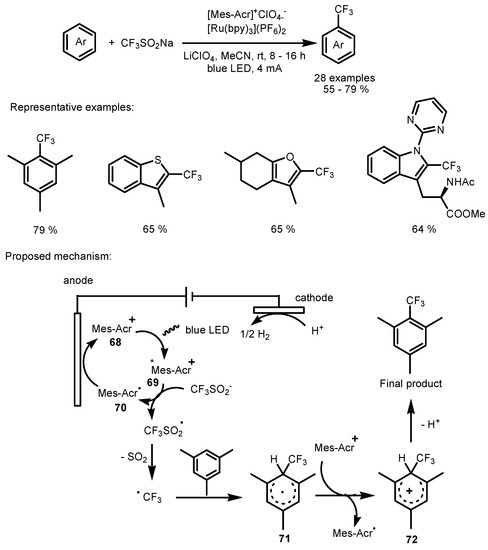
Scheme 17.
Electrophotochemical trifluoromethylation of arenes using acridinium photocatalyst and sodium triflinate.
In recent years, many other methods for photoredox catalytic oxidation of CF3SO2Na have been established. Sharada and coworkers reported a methylene blue-promoted regioselective C3-trifluoromethylation of 2H-indazoles (Scheme 18) [69].
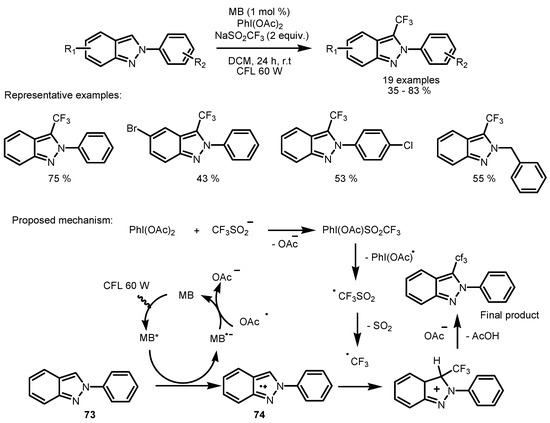
Scheme 18.
Visible-light-driven methylene blue-catalyzed trifluoromethylation of indazoles.
The combination of photocatalysis and hypervalent iodine reagent provides a practical approach to a variety of trifluoromethylated indazoles in 35−83% yields. In the proposed mechanism, the indazole 73 undergoes oxidation by the excited photocatalyst MB and then the photocatalytic cycle is closed via reduction of the photocatalyst by the acetate radical. On the other hand, the fluorinating agent is formed in the reaction of CF3SO2Na with phenyliodine(III) diacetate and the obtained adduct decomposes spontaneously, affording the •CF3. The addition of •CF3 to the oxidized indazole 74 followed by proton abstraction affords the final product. The presented mechanism is in contrast to that previously reported (Scheme 11) where the •CF3 is formed after reduction of hypervalent compound in the photocatalytic cycle. In the visible-light-mediated ortho-C−H trifluoromethylation of aniline derivatives using an Eosin Y/Cu dual catalytic system, CF3SO2Na is oxidized by SO4˙¯ formed by reduction of (NH4)2S2O8 (Scheme 19) [70].

Scheme 19.
Visible-light-driven Eosin Y-catalyzed trifluoromethylation of aniline derivatives.
The trifluoromethyl radical would be rapidly captured by Cu(II) species 75, affording a Cu(III)-CF3 intermediate 76. The radical 77 generated by the oxidized photocatalyst would be oxidized by Cu(III) species 76 and coordinate with Cu-CF3 to form 78. Complex 78 undergoes intramolecular trifluoromethylation, affording intermediate 79 and regenerating the Cu catalyst 75. Finally, intermediate 79 tautomerizes to afford the final product. It should be stressed that the reaction is regiospecific, affording exclusively ortho-substituted aniline derivatives. The oxidation of CF3SO2Na by SO4¯ to form the •CF3 is also a key step in the trifluoromethylation of arylcarbamates using 4,5-dichlorofluorescein (DCFS) as a photocatalyst [71]. In this case, however, the steric effect of DCFS would increase the steric hindrance of the ortho- and meta-positions on the phenyl ring, leading to the highly para-selective trifluoromethylation. Wang and coworkers developed a visible-light-induced Pd-catalyzed ortho-trifluoromethylation of acetanilides with CF3SO2Na (Scheme 20) [72]. Interestingly, both the substrate and products undergo excitation by a blue LED (410–415 nm) to generate the excited species, which acts as a photocatalyst. It was revealed that the 1O2 generated via energy transfer between excited photocatalyst and 3O2 can react with CF3SO2Na via single electron transfer to afford the superoxide radical anion O2˙¯ 80 and a CF3SO2 radical 81, which decomposes, generating a CF3 radical. On the other hand, the Pd catalytic cycle is initiated by C–H activation to afford palladacycle intermediate 82, which undergoes a reaction with the formed •CF3 to afford 83. The oxidation of 83 to 84 is followed by reductive elimination affording the final product and regenerating the Pd catalyst.
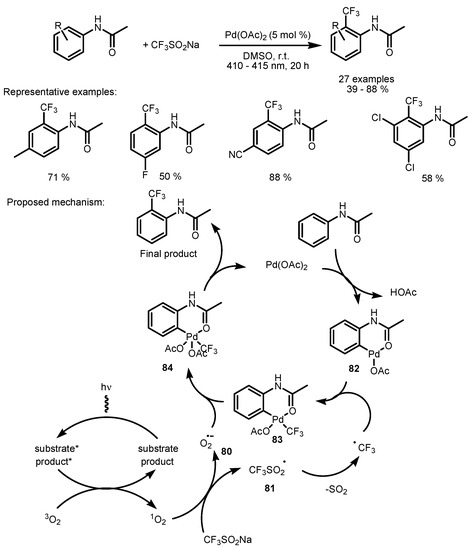
Scheme 20.
Visible-light-driven Pd-catalyzed trifluoromethylation of acetanilides with CF3SO2Na.
3. Trifluoromethylthiolation and Trifluoromethoxylation of Arenes
The Wangelin group reported a protocol of radical aromatic trifluoromethylthiolation of arenediazonium salts that is based on the facile generation of intermediate aryl radicals (Scheme 21) [73].
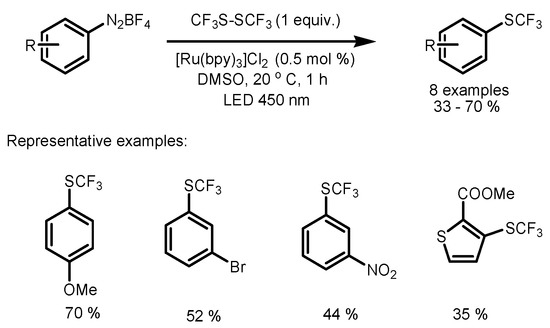
Scheme 21.
Visible-light-driven Ru-catalyzed trifluoromethylthiolation of arenediazonium salts using F3CS-SCF3.
Bis(trifluoromethyl) disulfide (F3CS-SCF3), which was used as the fluorinating species, is a commercial reagent that can also be freshly prepared by a literature procedure [74]. A series of arenediazonium salts were transformed into the desired aryl trifluoromethylsulfides in the presence of [Ru(bpy)3]Cl2 under irradiation with blue light (450 nm, 3.8 W LED) in moderate to good yields. The authors postulate a radical mechanism that is initiated by the photocatalytic reduction of the diazoacetate adduct formed in the reaction of arenediazonium salt with sodium acetate affording the aryl radical Ar•. The obtained Ar• undergoes rapid reaction with (SCF3)2 affording Ar-SCF3 and generating the trifluoromethylthiyl radical F3CS•. The formation of Ar• and F3CS• was confirmed by trapping with TEMPO. The authors hypothesize recombination of F3CS• with suitable nucleophiles (Nu = DMSO or acetate anion) during the reaction. Back-electron transfer (formally from the elusive [NuSCF3]•−) could be a potential pathway of photocatalyst regeneration.
Trifluoromethoxylation of arenes can be performed employing either radical fluoroalkoxylating reagents or some nucleophilic trifluoromethoxylating sources [75]. However, the photocatalytic approach of the synthesis of trifluoromethoxyarenes is worth mentioning. Ngai and coworkers reported the catalytic intermolecular trifluoromethoxylation of (hetero)arenes under photocatalytic conditions (Scheme 22) [76]. The key to success of this procedure was development of an easy-to-handle, photoactive trifluoromethoxylating reagent 85. This protocol was applicable to simple arenes containing common function groups including halides, carboxylic acids, ketones, esters, ethers, nitriles, carbonates, and phosphine oxides. Later, the same group reported a redox-active cationic reagent 86 capable of forming the OCF3 radical exclusively upon photocatalytic reduction [77]. This reagent is also applicable to the catalytic (hetero)aryl trifluoromethoxylation including a number of biorelevant compounds.

Scheme 22.
Visible-light-driven Ru-catalyzed trifluoromethoxylation of arenes and heteroarenes.
At the same time, Togni and coworkers disclosed the work on radical trifluoromethoxylation using a pyridinium-based reagent 87 [78]. A variety of simple aryl trifluoromethyl ethers bearing common functional groups were prepared and the reaction was also applicable to more complex structures including e.a. Femara® (anticancer treatment) or procymidone (a fruit fungicide). In the case of 85 and 87, the reaction occurs via photoreduction of these compounds with the formation of the •OCH3 followed by the addition of •OCH3 to the arene and the concomitant oxidation–deprotonation affording the final product. However, for 86 an alternative mechanism is proposed as it was found by the authors that the formation of the •OCF3 via the reduction of 86 by excited Ru(bpy)3(PF6)2 is unlikely. The reaction starts with the photoexcitation of the OCF3 reagent 86. This direct excitation is followed by a homolytic cleavage of the N-OCF3 bond to afford •OCF3 and an N-centered benzimidazole radical 88. The •OCF3 adds to an arene to afford the radical 89, while 88 is reduced by *Ru(bpy)3 to benzimidazole anion 90 (path A). The subsequent single-electron transfer from 89 to Ru(III) affords cyclohexadienyl cation 91 (path B), deprotonation of which restores the aromaticity and yields the desired aryl trifluoromethyl ether.
4. Perfluoroalkylation of Arenes
Even though several perfluorinated compounds are commercially available, the development of novel methods for efficient and selective introduction of fluorinated motifs is a growing area of interest because of the expansion of applications in medicinal, synthetic, industrial, and agricultural chemistry [79,80,81,82]. Synthetic procedures for direct couplings with perfluoroalkyl groups are relatively limited compared to trifluoromethylations. Perfluoroalkylated arenes were usually obtained utilizing the procedures developed for trifluoromethylation of aromatic compounds. For example, the conditions applied by Ye and coworkers [48] for trifluoromethylation of arylboronic acids using CF3I in a Cu/Ru dual catalytic system can also be utilized for perfluoroalkylation reactions. Using commercially available perfluorobutyl and perfluorodecyl iodides, the respective perfluoroalkylated biphenyls were obtained in good yields (Scheme 23). Similarly, the procedures of trifluoromethylation of arenes can also be extended for installation of -C2F5, -C3F7, -C6F13, and -C8F16 motifs into the aromatic system of alkoxybenzenes and nitrogen-based heterocycles [62,63,66,67].

Scheme 23.
Visible-light-driven perfluoroalkylation of arylboronic acids using perfluoroalkyl iodides in Ru/Cu dual catalytic system.
A simple and straightforward photocatalytic perfluoroalkylation method has been developed in continuous microflow, using commercially available [Ru(bpy)3]Cl2 as a photocatalyst and selected perfluoroalkyl iodides [83]. A selection of five-membered heteroaromatics were successfully perfluoroalkylated within several minutes. This flow synthesis technology exhibits merits such as high reaction yield (55–88%), mild reaction conditions (room temperature), atmospheric pressure, and excellent scale-up potential, which should allow easy implementation of this methodology in both academia and industry (Scheme 24). In the same year, the Noël group developed a remarkably efficient visible-light-photoinduced catalytic perfluoroalkylation of pyrroles and indoles in continuous flow using Eosin Y as the photoredox catalyst [84]. The Postigo group extended these studies, presenting a visible-light-driven transition-metal-free radical aromatic substitution reaction of aniline derivatives with perfluoroalkyl iodides in the presence of cesium carbonate as base and inexpensive Rose Bengal (RB) as organophotocatalyst in MeCN as solvent (Scheme 25) [85]. A series of perfluoroalkyl-substituted aniline derivatives were obtained in good to excellent yields, however, in the case of unsubstituted aniline the formation of the mixture of para- and ortho-isomers was observed. The proposed mechanism involves the excitation of RB 92 to RB* 93, which transfers an electron to n-C4F9I, generating •C4F9 radical 94 and the radical cation RB·+. The addition of 94 to aniline affords the radical 95 which is next oxidized by n-C4F9I to 96. This step can propagate the chain process of the formation of •C4F9. The hydrogen abstraction from 96 by Cs2CO3 affords the final product. The authors hypothesize that the RB·+ radical cation also accepts an electron from Cs2CO3 to regenerate RB. The fact that addition of Cs2CO3 to the photocatalytic reactions significantly improved the perfluorobutylation yields could support the role of the base as an electron-donor adjuvant to regenerate the catalyst.
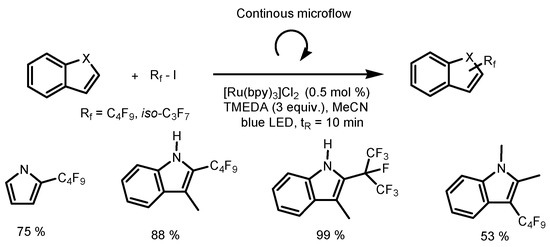
Scheme 24.
Visible-light-driven Ru-catalyzed perfluoroalkylation of heteroaromatic compounds using perfluoroalkyl iodides.

Scheme 25.
Visible-light-driven Rose Bengal-catalyzed perfluoroalkylation of aniline derivatives using perfluoroalkyl iodides.
A series of aniline derivatives were efficiently perfluoroalkylated using fac-Ir(ppy)3 (0.1%) in the presence of K2CO3 in DCM at room temperature under blue light irradiation (Scheme 26) [86].

Scheme 26.
Visible-light-driven Ir-catalyzed perfluoroalkylation of aniline derivatives using perfluoroalkyl iodides.
The substrates bearing electro-neutral and electro-donating groups underwent the perfluoroalkylation smoothly and furnished products in good to excellent yields. For para-substituted derivatives, only ortho-substituted aniline was formed, however, a mixture of regio-isomers with an almost 1/1 ratio (ortho/para) was obtained when methyl 3-amino-4-iodobenzoate was examined. Meanwhile, only para-substituted perfluoroalkylated aniline was formed when di-ortho-substituted aniline was employed as a substrate. According to the proposed mechanism, the reaction starts with the excitation of the photocatalyst [Ir(ppy)3] 97 with blue LEDs. Subsequent single-electron transfer from 98 to RfI generates perfluoroalkyl radical 99 and Ir(IV)(ppy)3 100. The newly formed radical intermediate reacts with free aniline to produce intermediate 101, which is oxidized by 100, followed by the abstraction of a proton with the base to provide the perfluoroalkylated product. The Ritter group has revealed that photoredox-catalyzed cross-coupling of aryl thianthrenium salts with a copper-based trifluoromethyl reagent for a site-selective trifluoromethylation can also be utilized for the introduction of a pentafluoroethyl group (Scheme 27) [49]. The mesoporous graphitic carbon nitride (mpg-CN) photocatalyst utilized by the Blechert group to trifluoromethylate various arenes was further applied to obtain 2-perfluorobutyl pyrrole (Scheme 28) [39]. High reactivity (85%) was observed in the case of perfluorobutyl sulfonyl chloride as the fluorinating agent, however, double fluoroalkylation product at positions 2 and 5 of pyrrole was also obtained (8%). The use of perfluorobutyl sulfonyl fluoride showed only a slow reaction with a low conversion to the desired product (17%). This can be explained by the stronger S-F bond compared to the S-Cl bond that inhibits a fast degradation after reduction to generate the perfluoroalkyl radical. On the other site, using perfluorobutyl iodide, the reaction was slower than with perfluorobutyl sulfonyl chloride, but a good yield of 68% of the desired product was achieved.
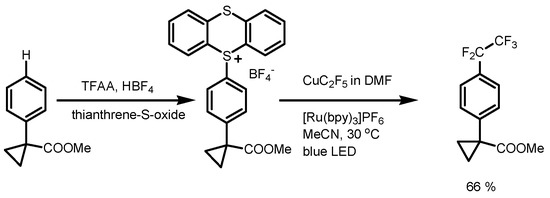
Scheme 27.
Visible-light-driven Ru-catalyzed perfluoroethylation of heteroaromatic compounds using Cu-based trifluoromethyl reagent.

Scheme 28.
Visible-light-driven mpg-CN-catalyzed perfluoroalkylation of pyrrole using various perfluorobutyl reactants.
Wang and coworkers reported a photocatalyzed, copper-mediated system for ortho-perfluoroalkylation of 8-aminoquinoline-derived benzamides using Eosin Y as the photocatalyst (Scheme 29) [87].

Scheme 29.
Visible-light-driven Eosin Y-catalyzed perfluoroalkylation of benzamides.
A series of benzamides were selectively perfluoroalkylated at the ortho-position. A plausible mechanism involves formation of cyclometalated complex 103 from C-H activation of 102 with copper salt. Perfluoroalkyl radicals formed by the reaction of perfluoroalkyl iodides with excited photocatalyst react with 103 to form a Cu III complex 104. Finally, reductive elimination of 104 affords the desired product. Arenes could also be perfluoroalkylated using perfluoroalkyl iodides in the presence of heterogenic photocatalysts such as TiO2, carbon nitride or via formation of EDA complexes [88,89,90].
To extend the application of hypervalent iodine(III) acetates utilized by the Qing group, the analogous fluoroalkylation reactions were examined using perfluoroethyl and perfluoropropyl derivatives C6F5I(OCORf)2 (Scheme 30) [59].

Scheme 30.
Visible-light-driven Ru-catalyzed perfluoroalkylation using perfluoroalkylated hypervalent iodine(III) acetates.
These reactions proceeded smoothly under the standard conditions, resulting in the pentafluoroethylated and heptafluoropropylated products in moderate yields.
5. Monofluorination of Arenes
Although various fluorination procedures have been developed, the known synthetic methods usually involve the use of toxic and dangerous atomic fluorine sources, often affording a mixture of mono- and difluorinated compounds [91,92,93,94]. Radical fluorination reactions have been developed as an efficient methodology for the fluorination of complex molecules [95,96,97]. However, these reactions require further study mainly involving the improvement of regiospecificity and the ability to use cheap and readily available starting materials. The concept of visible-light-driven photocatalysis has been proved attractive for the direct C-F bond formation. Fukuzumi and coworkers reported the photocatalytic system using tetraethylammonium fluoride tetrahydrogen fluoride salt (TEAF•4HF) as fluorinating reagent in the presence of 3-cyano-1-methylquinolinium perchlorate (QuCN+ClO4−) as photocatalyst (Scheme 31) [98]. Using acetonitrile as a solvent under irradiation of a 500 W xenon lamp, fluorobenzene was obtained in 20% yield after 50 min of irradiation. Chloro- and bromobenzene were also fluorinated, however, the corresponding para-substituted products were formed in low yield (7 and 6%). The proposed mechanism involves reaction of the excited photocatalyst 105 with arene 106 to generate arene radical cation 107 existing in equilibrium with its dimer radical cation 108. TEAF•4HF reacts with 107, affording the aryl radical 109. The O2•− radical formed upon reduction of oxygen in the photocatalytic cycle abstracts hydrogen from radical 109 to afford the desired fluorinated product.

Scheme 31.
Visible-light-driven quinoline-catalyzed fluorination of benzene derivatives using TEAF·4HF.
The Nicewicz group developed an organic photoredox system for direct arene C−H radiofluorination, using 18F−NBu4+ as a fluorinating agent and molecular oxygen as an oxidant [99]. This procedure is especially valuable because fluorine-18 is the most widely used positron emission tomography (PET) isotope. Using laser irradiation to excite an acridinium photocatalyst, unactivated arenes were effectively fluorinated, affording a wide range of 18F-labeled arenes and heteroaromatics, including pharmaceutical compounds and PET tracers. In order to replace the expensive laser light source and to exclude the necessity of bubbling the oxygen through the reaction vessel, the same group developed a photoredox system and apparatus that allow for direct C−H radiofluorination, using a readily available 425 nm LED light source (Scheme 32) [100]. In order to increase the overall light influx needed, the reactions were performed using a microtubing reactor that greatly increased the surface area being exposed to the light source. After optimization studies, tert-butylperoxy acetate (TBPA) was selected as the optimal oxidant in tert-butanol as the optimal solvent. The availability of the wide range of organic photocatalysts prompted the authors to perform a catalyst screening. Generally, acridinium salts were the most suitable catalysts for radiofluorination and the compound 110 was selected as the most efficient photocatalyst. Amongst twenty-two examples of examined arenes, eleven of the substrates demonstrated improved yields, and ten of them showed comparable or decreased yields. A significant improvement (23% yield) was observed for 4-chromanone for which the previous method proved to be ineffective. The regioselectivity observed in this study generally follows the same trends observed in previous photoredox arene C−H fluorination studies affording functionalization occurring ortho or para to an electron-donating group. The mechanistic proposal for this reaction involves oxidation of an arene 111 by the excited photocatalyst 110* affording the carbocation 112 which undergoes nucleophilic attack by F−. The oxidant is presumed to react with the radical 113 to lead to alkylperoxyl radical 114. Intramolecular hydrogen atom transfer and extrusion of an alcohol unit (R’OH) would then furnish the fluorinated arene. The radical scavenger (TEMPO) reacts rapidly with the cyclohexadienyl radical via hydrogen atom abstraction to yield the corresponding aromatic compound.

Scheme 32.
Visible-light-driven acridinium dye-catalyzed radiofluorination of arenes using 18FNBu4.
Ritter and coworkers revealed that metallophotoredox catalysis combined with exquisitely selective aromatic C–H functionalization by thianthrenation can now be employed to produce synthetically valuable fluorinated analogues of complex small molecules (Scheme 33) [101]. Fluorination is successful on electron-deficient, -neutral, and -rich arenes, as well as on substrates that bear ortho-substituents. The reaction is tolerant towards aldehydes, esters, heterocycles, benzyl ethers, carbamates, amides, acid-sensitive glycosidic linkages, and ketones. Protic groups, which are not compatible with other nucleophilic and electrophilic transition metal-catalyzed fluorination reactions, are tolerated in copper-mediated photoredox fluorination. In the proposed mechanism, arylthianthrenium salt 115 is reduced by the photocatalyst 116, repelling thianthrenium 117 and affording the aryl radical 118. The obtained radical 118 undergoes addition to the Cu(II) compound 119 followed by complexation with F−, affording the intermediate 120. The reductive elimination of 120 gives the final product and the Cu(I) 121 compound which is next oxidized to Cu(II) 119 by the thianthrenium radical 122 obtained after oxidation of thianthrene in the photocatalytic cycle. The mechanism of the reaction is accurately supported by kinetical experiments (fragmentation rates of arylthianthrenium salts), Stern–Volmer measurements (effective reductive quenching of the excited iridium photocatalyst by thianthrene), and TEMPO trapping studies (formation of adducts with aryl radicals).
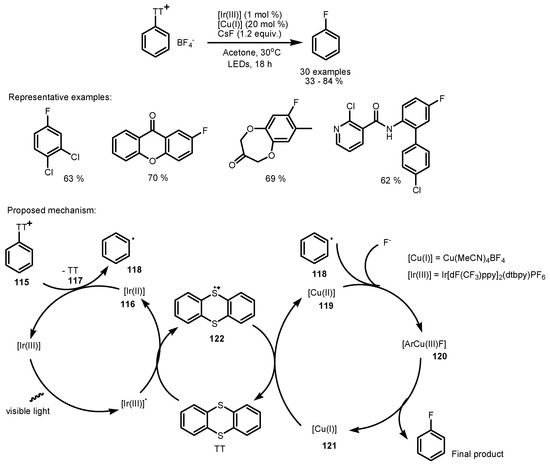
Scheme 33.
Visible-light-driven Ir-catalyzed fluorination of arenes using arylthianthrenium salts.
6. Fluorosulfonation of Arenes
Tlili and coworkers reported the first photocatalytic metal-free procedure for the synthesis of arylsulfonyl fluorides (Scheme 34) [102]. The reaction involves the use of aryl diazonium salts, 1,4-diazabicyclo[2.2.2]octane bis(sulfur dioxide) adduct (DABSO) as the fluorine source, and the cyanoarene photocatalyst 123 under blue LED irradiation. The mild conditions afforded a broad scope and high functional group tolerance including electron-donating and -accepting substituents in benzene derivatives. Steric hindrance was not deleterious to the reaction outcome, since up to 80% yields were reached for ortho-substituted methoxyphenyl derivative. Interestingly, heterocyclic compounds could also be converted to their corresponding sulfonyl fluorides in moderate yields. According to the proposed mechanism, photoinduced reduction of the diazonium salt by the excited 123* yields arene radical 124 and radical cation photocatalyst 125. Subsequently, the aryl radical collapses with SO2 to form a new radical tosyl species 126. The released DABCO 127 regenerates the photocatalyst 123 in its ground state and 128. The latter may combine with 126 to generate the sulfonium salt intermediate 129. The nucleophilic fluorine attack on 129 affords the final product and regenerates DABCO. It should be stressed that the presented mechanism is supported by quantum-mechanical calculations.
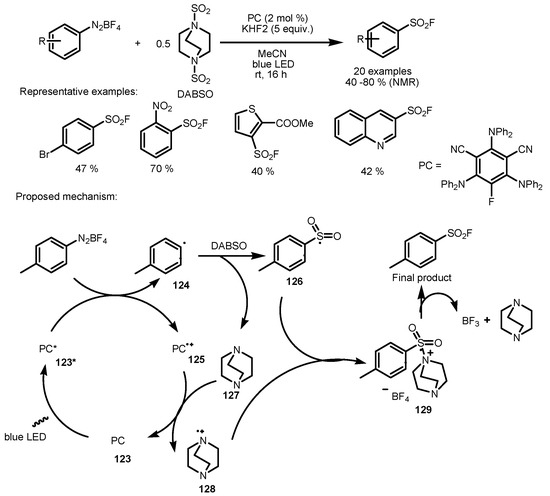
Scheme 34.
Visible-light-driven cyanoarene-catalyzed fluorosulfonation of arenes using DABSO.
7. Tandem Photocatalytic Fluorination–Aromatization Processes
The previously reported general methods for the synthesis of aromatic derivatives bearing a fluorine or perfluoroalkyl group in a specific position display in some cases poor regioselectivity and require the direct use of preformed or commercially available aromatic counterparts. The alternative strategy exploits tandem reactions by combining organo-photoredox-catalyzed radical fluoroalkylation of the non-aromatic part of the molecule followed by a reaction sequence leading to aromatization [103,104]. However, in this review article, the emphasis will be put exclusively on reactions leading to the installation of the fluorinated group directly into the aromatic core. Yu and coworkers developed a convenient approach to obtain 6-alkylated phenanthridines using various biphenyl-based isocyanides and alkyl bromides in the presence of fac-Ir(ppy)3 as the photocatalyst (Scheme 35) [105]. The reaction proceeded at room temperature in good to excellent yields in the absence of external stoichiometric oxidants. Within a broad substrate scope, two fluorinated bromides were used, affording the respective perfluoroalkylated products. Based on the authors’ observations, photocatalyst fac-Ir(ppy)3 is irradiated to the excited state 130 which is oxidatively quenched by 131 with the formation of 132 and a radical species 133. The radical 133 is added to 134 to produce the imidoyl radical intermediate 135, which undergoes intramolecular cyclization to give the radical intermediate 136. The intermediate 136 is then oxidized by 132 to form 137 and regenerating fac-Ir(ppy)3. Ultimately, deprotonation assisted by the base yields the final product.
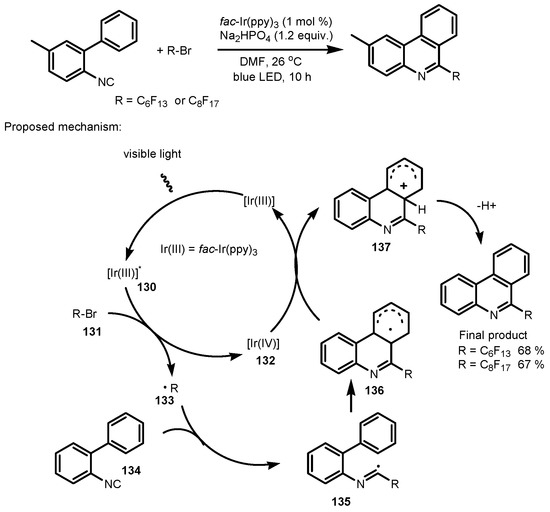
Scheme 35.
Visible-light-driven Ir-catalyzed synthesis of 6-perfluoroalkylated phenanthridines.
The extention of this reaction type involved the use of Umemoto reagent 138 E[A/A−1] = (−0.61 V vs. SCE) in the presence of Ir(ppy)2(dtbbpy)PF6 as the photocatalyst (Scheme 36) [106]. The methodology presented by the authors provides access to highly fuctionalized 1-trifluoromethylisoquinolines under mild conditions in good to excellent yields. The proposed mechanism involves generation of •CF3 and radical cation 139 via homolytic cleavage of 138 (path A) assisted by visible light which is supported by theoretical calculations. The radical cation 139 E[A/A−1] = (0.06 V vs. SCE) is reduced to sulfide 140 by the excited photocatalyst 141 E[A/A−1] = (−0.75 V vs. SCE). The •CF3 species is trapped by isocyanide 142 to give radical 143, which undergoes intramolecular cyclization affording radical 144. The aryl radical 144 E[A/A−1] = (−0.65 V vs. SCE) is then oxidized by Ir(IV) E[A/A−1] = (1.14 V vs. SCE) to aryl cation 145 and regenerates Ir(III). Finally, deprotonation assisted by a base yields the final product. The authors suggest that •CF3 can also be generated upon direct reduction of 138 by the excited photocatalyst 141 (path B).
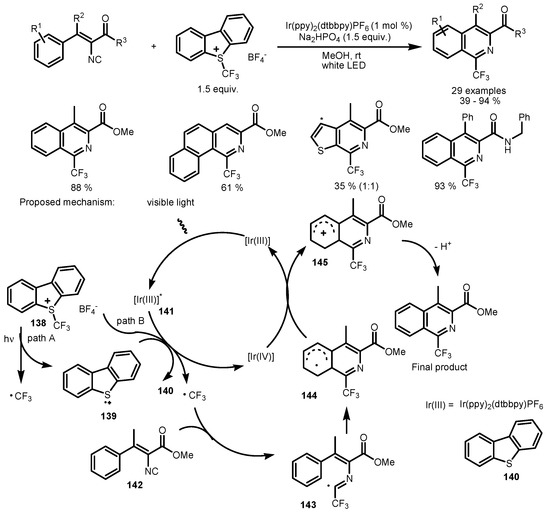
Scheme 36.
Visible-light-driven Ir-catalyzed synthesis of 1-trifluoromethylisoquinolines.
Li and coworkers developed a radical-triggered cyclization of o-alkenyl aromatic isocyanides prepared from accessible starting materials (Scheme 37) [107]. The reaction provides a general and efficient method for the synthesis of 4-CN-2-CF2H-containing quinolines under visible-light photoredox catalysis in a one-pot synthetic procedure. A wide scope of o-alkenyl aromatic isocyanides bearing different electron-withdrawing and electron-donating groups at the ortho-, meta-, and para-position of phenyl ring were tolerated, affording the products in moderate to high yields. The thiophene or cyclohexyl substrate also furnished the products in 23 and 39% yields, respectively. Based on the proposed mechanism, the reaction involves reduction of 146 by the excited photocatalyst affording the •CHF2 radical 147. The subsequent addition of 147 to the C=N bond of the isonitrile group affords the radical 148 which next cyclizes to 149 via a 6-endo path. The alternative three-step cyclization path is also considered. The obtained radical is next oxidized to 150 and after H+ abstraction the final product is formed. Shen and coworkers have developed a metal-free, visible-light photoredox-catalyzed three-component reaction for the facile assembly of fluoroalkylated pyrimidine derivatives in a regiodefined [3 + 2 + 1] manner, starting from readily available building blocks of silyl enol ether, amidine, and fluoroalkyl halide (Scheme 38) [108].
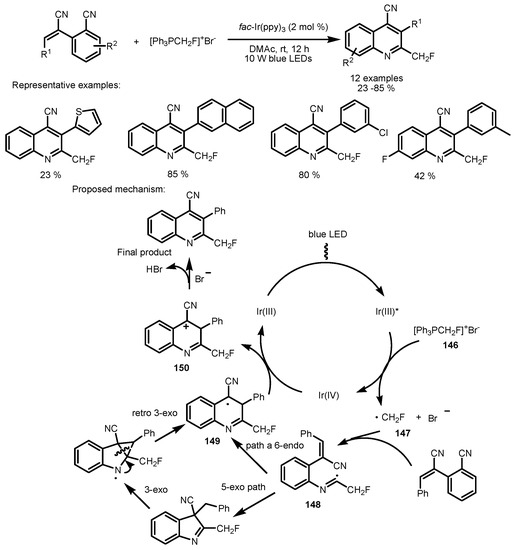
Scheme 37.
Visible-light-driven Ir-catalyzed difluoromethylation-cyclization for the synthesis of quinolines.
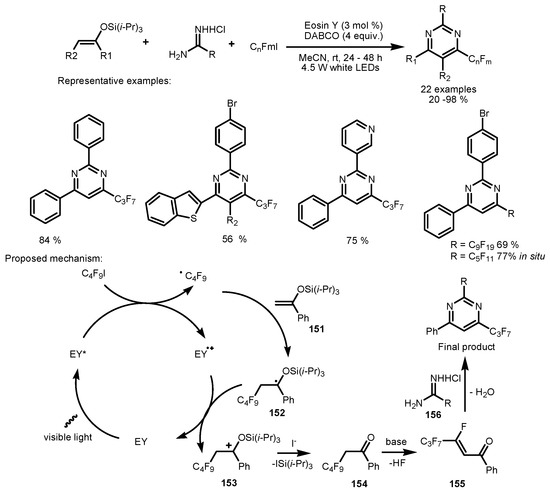
Scheme 38.
Visible-light-driven Eosin Y-catalyzed synthesis of pyrimidines using three-component reaction.
A concise, two-step, one-flask procedure was designed for the synthesis of the test pyrimidine derivative (84% yield) by using benzamidine hydrochloride, triisopropylsilyl enol ether (1.8 equiv.), perfluorobutyliodide (3 equiv.), DABCO (3 equiv.), and Eosin Y (3%) as the photocatalyst. With the optimal reaction conditions in hand, the authors successfully extended the substrate scope of the reaction to benzamidines containing diverse substituents of varying electronic character and steric hindrance on the phenyl moieties, affording the corresponding products in high yields (70–98%). In the same manner, the reactions worked equally well with heteroaryl amidines and C-alkylated reactants. The substrate scope with respect to a series of structurally varied silyl enol ethers also led to satisfactory yields. In addition to perfluorobutyl iodide, the applicability of this transformation to a broad spectrum of fluoroalkyl halides (C2F5I, C5F11I, C7H15I, and C8F17I) was observed. According to the proposed mechanism, the reaction involves a single-electron transfer from the excited photocatalyst EY* to fluoroalkyl halide to produce the •C4F9 radical and a radical cation EY•+. Next, tertiary carbocation 153 is generated via the addition of a perfluoroalkyl radical to the C=C bond of silyl enol ether 151, followed by further oxidation with the aid of the oxidative radical cation EY•+. After rapid attack by an I− ion, the α-perfluoroalkylated ketone 154 is formed. In a defluorination step, α,β-desaturation of 154 is enabled by eliminating a molecule of HF under basic conditions, affording 155. Finally, ring closure involving intermolecular [3 + 3] condensation of 155 with amidine 156 proceeds to afford the final product. It is worth noting that the reaction allowed efficient access to heterocyclic adducts with appreciable yields by utilizing in situ formed enolsilanes 151 from related ketones, followed by exposure to photocatalytic conditions in a single reaction vessel.
8. Conclusions
This review demonstrates that visible-light-driven photocatalysis contributed essentially to the development of reactions, allowing the easy formation of fluorinated aromatic compounds. Diverse methods to install a fluorine atom or the fluorine-containing moiety have been successfully employed, including generation of reactive perfluoroalkyl radicals by direct reduction of the C-I bond in perfluoroalkyl iodides, single-electron reduction of trifluoromethylsulfonyl chloride, hypervalent iodine, and sulfur compounds, or oxidation of sodium triflinate. The monofluorination of arene procedures are noteworthy, including addition of the fluorine anion to the aryl radicals formed in the photocatalytic cycle. Interestingly, we have seen progress in the development of new fluorine-containing precursors allowing the introduction of SCF3, OCF3, or SO2F moiety to the aromatic system. The photocatalytic fluorination of arenes in a dual catalytic system (Ir/Cu or Ru/Cu) enabled the easy fluorination of a variety of arenes. In particular, the strategy developed by MacMillan’s group is noteworthy, allowing a general trifluoromethylation of aryl bromides through dual copper-photoredox catalysis by overcoming the copper oxidative addition problem with an aryl radical capture mechanism. The novel strategy exploiting a tandem relay by combining organo-photoredox-catalyzed radical fluoroalkylation and post-photocatalytic aromatization provides a general and highly efficient method for the one-pot synthesis of quinolines and pyrimidines from acyclic starting materials. In spite of its attractive features such as synthetic simplicity, a broad substrate scope, and excellent functional group compatibility under mild reaction conditions, further research work in this field is still needed. We predict that merging of different photocatalytic approaches to incorporate perfluoroalkyl groups will be developed, such as scale-up flow synthesis and enantioselective catalysis, which would result in novel types of fluorinated aromatic compounds which will serve in agrochemical, pharmaceutical, and material chemical industries.
Funding
This work was supported by the Warsaw University of Technology, Grant RND Nchem.3 43.122203.
Conflicts of Interest
The author declares no conflict of interest.
References
- Muller, K.; Faeh, C.; Diederich, F. Fluorine in pharmaceuticals: Looking beyond intuition. Science 2007, 317, 1881–1886. [Google Scholar] [CrossRef]
- Kirsch, P. Modern Fluoroorganic Chemistry: Synthesis, Reactivity, Applications, 2nd ed.; Wiley-VCH: Weinheim, Germany, 2013. [Google Scholar]
- Hird, M. Fluorinated liquid crystals—Properties and applications. Chem. Soc. Rev. 2007, 36, 2070–2095. [Google Scholar] [CrossRef] [PubMed]
- Kirk, K.L. Fluorination in medicinal chemistry: Methods, strategies, and recent developments. Org. Process Res. Dev. 2008, 12, 305–321. [Google Scholar] [CrossRef]
- O’Hagan, D. Understanding organofluorine chemistry. An introduction to the C–F bond. Chem. Soc. Rev. 2008, 37, 308–319. [Google Scholar] [CrossRef] [PubMed]
- Wang, C.; Chen, Z.; Wu, W.; Mo, Y. How the generalized anomeric effect influences the conformational preference. Chem. Eur. J. 2013, 19, 1436–1444. [Google Scholar] [CrossRef] [PubMed]
- Wang, Y.C.; Liu, L.Q.; Wang, G.M.; Ouyang, H.; Li, Y.J. Catalyst-free room-temperature decarboxylative tri- or tetrafunctionalization of alkynyl carboxylic acids with N-fluorobenzenesulfonimide (NFSI) and diselenides. Green Chem. 2018, 20, 604–608. [Google Scholar] [CrossRef]
- Wang, X.; Lei, J.; Liu, Y.J.; Ye, Y.; Li, J.Z.; Sun, K. Fluorination and fluoroalkylation of alkenes/alkynes to construct fluoro-containing heterocycles. Org. Chem. Front. 2021, 8, 2079–2109. [Google Scholar] [CrossRef]
- Sun, K.; Wang, S.N.; Feng, R.R.; Zhang, Y.X.; Wang, X.; Zhang, Z.G.; Zhang, B. Copper-catalyzed radical selenodifluoromethylation of alkenes: Access to CF2-containing γ-lactams. Org. Lett. 2019, 21, 2052–2055. [Google Scholar] [CrossRef]
- Li, Y.; Tan, L.; Wang, Z.H.; Qian, H.L.; Shi, Y.B.; Hu, W.P. Air-stable n-type semiconductor: core-perfluoroalkylated perylene bisimides. Org. Lett. 2008, 10, 529–532. [Google Scholar] [CrossRef]
- Matsugi, M.; Curran, D.P. Synthesis, reaction, and recycle of light fluorous Grubbs−Hoveyda catalysts for alkene metathesis. J. Org. Chem. 2005, 70, 1636–1642. [Google Scholar] [CrossRef]
- Tattersall, F.D.; Rycroft, W.; Cumberbatch, M.; Mason, G.; Tye, S.; Williamson, D.J.; Hale, J.J.; Mills, S.G.; Finke, P.E.; MacCoss, M.; et al. The novel NK1 receptor antagonist MK-0869 (L-754,030) and its water soluble phosphoryl prodrug, L-758,298, inhibit acute and delayed cisplatin-induced emesis in ferrets. Neuropharmacology 2000, 39, 652–663. [Google Scholar] [CrossRef]
- Chauret, N.; Guay, D.; Li, C.; Day, S.; Silva, J.; Blouin, M.; Ducharme, Y.; Yergey, J.A.; Nicoll-Griffith, D.A. Improving metabolic stability of phosphodiesterase-4 inhibitors containing a substituted catechol: Prevention of reactive intermediate formation and covalent binding. Bioorganic Med. Chem. Lett. 2002, 12, 2149–2152. [Google Scholar] [CrossRef]
- Robertson, J.F.R.; Come, S.E.; Jones, S.E.; Beex, F.; Kaufmann, M.; Makris, A.; Nortier, J.W.R.; Possinger, K.; Rutqvist, L.E. Endocrine treatment options for advanced breast cancer—The role of fulvestrant. Eur. J. Cancer 2005, 41, 346–356. [Google Scholar] [CrossRef] [PubMed]
- Prier, C.K.; Rankic, D.A.; MacMillan, D.W.C. Visible light photoredox catalysis with transition metal complexes: Applications in organic synthesis. Chem. Rev. 2013, 113, 5322–5363. [Google Scholar] [CrossRef] [PubMed]
- Xuan, J.; Xiao, W.J. Visible light photoredox catalysis. Angew. Chem. Int. Ed. 2012, 51, 6828–6838. [Google Scholar] [CrossRef] [PubMed]
- Tóth, B.L.; Tischler, O.; Novák, Z. Recent advances in dual transition metal–visible light photoredox catalysis. Tetrahedron Lett. 2016, 57, 4505–4513. [Google Scholar] [CrossRef]
- Shaw, M.H.; Twilton, J.; MacMillan, D.W.C. Photoredox catalysis in organic chemistry. J. Org. Chem. 2016, 81, 6898–6926. [Google Scholar] [CrossRef] [PubMed]
- Kancherla, R.; Muralirajan, K.; Sagadevan, A.; Rueping, M. Visible light-induced excited-state transition-metal catalysis. Trends Chem. 2019, 1, 510–523. [Google Scholar] [CrossRef]
- McAtee, R.C.; McClain, E.J.; Stephenson, C.R.J. Illuminating photoredox catalysis. Trends Chem. 2019, 1, 111–125. [Google Scholar] [CrossRef] [PubMed]
- Guo, J.J.; Hu, A.; Zuo, Z. Photocatalytic alkoxy radical-mediated transformations. Tetrahedron Lett. 2018, 59, 2103–2111. [Google Scholar] [CrossRef]
- Courant, T.; Masson, G. Recent progress in visible-light photoredox-catalyzed intermolecular 1,2-difunctionalization of double bonds via an ATRA-type mechanism. J. Org. Chem. 2016, 81, 6945–6952. [Google Scholar] [CrossRef]
- Lantaño, B.; Torviso, M.R.; Bonesi, S.M.; Barata-Vallejoa, S.; Postigo, A. Advances in metal-assisted non-electrophilic fluoroalkylation reactions of organic compounds. Coord. Chem. Rev. 2015, 285, 76–108. [Google Scholar] [CrossRef]
- Lantaño, B.; Postigo, A. Radical fluorination reactions by thermal and photoinduced methods. Org. Biomol. Chem. 2017, 15, 9954–9973. [Google Scholar] [CrossRef] [PubMed]
- Bui, T.T.; Hong, W.P.; Kim, H.-K. Recent Advances in Visible Light-mediated Fluorination. J. Fluor. Chem. 2021, 247, 109794. [Google Scholar] [CrossRef]
- Yakubov, S.; Barham, J.P. Photosensitized direct C–H fluorination and trifluoromethylation in organic synthesis. Beilstein J. Org. Chem. 2020, 16, 2151–2192. [Google Scholar] [CrossRef] [PubMed]
- Akita, M.; Koike, T. Principles and applications of photoredox catalysis: Trifluoromethylation and beyond. J. Synth. Org. Chem. Jpn. 2016, 74, 1036–1046. [Google Scholar] [CrossRef]
- Lantano, B.; Torviso, M.R.; Bonesi, S.M.; Barata-Vallejo, S.; Postigo, A. Late-stage electron-catalyzed perfluoroalkylation of coumarine derivatives—thermal fluoroalkyl radical production from sodium perfluoroalkyl sulfinate salts. J. Fluor. Chem. 2017, 197, 42–48. [Google Scholar]
- Lee, K.N.; Lee, J.W.; Ngai, M.Y. Recent development of catalytic trifluoromethoxylation reactions. Tetrahedron 2018, 74, 7127–7135. [Google Scholar] [CrossRef]
- Barata-Vallejo, S.; Postigo, A. New visible-light-triggered photocatalytic trifluoromethylation reactions of carbon–carbon multiple bonds and (hetero)aromatic compounds. Chem. Eur. J. 2020, 26, 11065–11084. [Google Scholar] [CrossRef]
- Baguia, H.; Evano, G. Direct perfluoroalkylation of C-H bonds in (hetero)arenes. Chem. Eur. J. 2022, 28, e202200975. [Google Scholar] [CrossRef]
- Liu, T.; Liu, J.; He, J.; Hong, Y.; Zhou, H.; Liu, Y.-L.; Tang, S. Recent advances in photoinduced perfluoroalkylation using perfluoroalkyl halides as the radical precursors. Synthesis 2022, 54, 1919–1938. [Google Scholar]
- Barata-Vallejo, S.; Bonesi, S.M.; Postigo, A. Perfluoroalkylation reactions of (hetero)arenes. RSC Adv. 2015, 5, 62498–62518. [Google Scholar] [CrossRef]
- Lemos, A.; Lemaire, C.; Luxena, A. Progress in difluoroalkylation of organic substrates by visible light photoredox catalysis. Adv. Synth. Catal. 2019, 361, 1500–1537. [Google Scholar] [CrossRef] [PubMed]
- Ojima, I. Fluorine in Medical Chemistry and Chemical Biology; Wiley-Blackwell: Chichester, UK, 2009. [Google Scholar]
- Jeschke, P. The unique role of fluorine in the design of active ingredients for modern crop protection. ChemBioChem 2004, 5, 570–589. [Google Scholar] [CrossRef]
- Nagib, D.A.; MacMillan, D.W.C. Trifluoromethylation of arenes and heteroarenes by means of photoredox catalysis. Nature 2011, 224–228. [Google Scholar] [CrossRef] [PubMed]
- Pal, A.K.; Li, C.; Hanan, G.S.; Zysman-Colman, E. Blue-emissive cobalt (III) complexes and their use in the photocatalytic trifluoromethylation of polycyclic aromatic hydrocarbons. Angew. Chem. Int. Ed. 2018, 57, 8027–8031. [Google Scholar] [CrossRef] [PubMed]
- Baar, M.; Blechert, S. Graphitic carbon nitride polymer as a recyclable photoredox catalyst for fluoroalkylation of arenes. Chem. Eur. J. 2015, 21, 526–530. [Google Scholar] [CrossRef]
- Maiti, B.; Abramov, A.; Pérez-Ruiz, R.; Díaz Díaz, D. The prospect of photochemical reactions in confined gel media. Acc. Chem. Res. 2019, 52, 1865–1876. [Google Scholar] [CrossRef]
- Strekowski, L.; Hojjat, M.; Patterson, S.E.; Kiselyov, A.S. Experimental and computational studies of trifluoromethylation of aromatic amines by the system trifluoroiodomethane-zinc-sulfur dioxide. J. Heterocycl. Chem. 1994, 31, 1413–1416. [Google Scholar] [CrossRef]
- Sato, K.; Omote, M.; Ando, A.; Kumadaki, I. Rhodium-catalyzed novel trifluoromethylation at the α-position of α,β-unsaturated ketones. Org. Lett. 2004, 6, 4359–4361. [Google Scholar] [CrossRef]
- Mikami, K.; Tomita, Y.; Ichikawa, Y.; Amikura, K.; Itoh, Y. Radical trifluoromethylation of ketone silyl enol ethers by activation with dialkylzinc. Org. Lett. 2006, 8, 4671–4673. [Google Scholar] [CrossRef] [PubMed]
- Itoh, Y.; Houk, K.N.; Mikami, K. Experimental and theoretical studies on radical trifluoromethylation of titanium ate and lithium enolates. J. Org. Chem. 2006, 71, 8918–8925. [Google Scholar] [CrossRef] [PubMed]
- Kino, T.; Nagase, Y.; Ohtsuka, Y.; Yamamoto, K.; Uraguchi, D.; Tokuhisa, K.; Yamakawa, T. Trifluoromethylation of various aromatic compounds by CF3I in the presence of Fe(II) compound, H2O2 and dimethylsulfoxide. J. Fluor. Chem. 2010, 131, 98–105. [Google Scholar] [CrossRef]
- Ye, Y.; Lee, S.H.; Sanford, M.S. Silver-mediated trifluoromethylation of arenes using TMSCF3. Org. Lett. 2011, 13, 5464–5467. [Google Scholar] [CrossRef] [PubMed]
- Andrieux, C.P.; Gelis, L.; Medebielle, M.; Pinson, J.; Saveant, J.M. Outer-sphere dissociative electron transfer to organic molecules: A source of radicals or carbanions? Direct and indirect electrochemistry of perfluoroalkyl bromides and iodides. J. Am. Chem. Soc. 1990, 112, 3509–3520. [Google Scholar] [CrossRef]
- Ye, Y.; Sanford, M.S. Merging visible-light photocatalysis and transition-metal catalysis in the copper-catalyzed trifluoromethylation of boronic acids with CF3I. J. Am. Chem. Soc. 2012, 134, 9034–9037. [Google Scholar] [CrossRef] [PubMed]
- Ye, F.; Berger, F.; Jia, H.; Ford, J.; Wortman, A.; Börgel, J.; Genicot, C.; Ritter, T. Aryl sulfonium salts for site-selective late-stage trifluoromethylation. Angew. Chem. Int. Ed. 2019, 58, 14615–14619. [Google Scholar] [CrossRef]
- Iqbal, N.; Choi, S.; Ko, E.; Cho, E.J. Trifluoromethylation of heterocycles via visible light photoredox catalysis. Tetrahedron Lett. 2012, 53, 2005–2008. [Google Scholar] [CrossRef]
- Choi, W.J.; Choi, S.; Ohkubo, K.; Fukuzumi, S.; Cho, E.J.; You, Y. Mechanisms and applications of cyclometalated Pt(II) complexes in photoredox catalytic trifluoromethylation. Chem. Sci. 2015, 6, 1454–1464. [Google Scholar] [CrossRef]
- Zhdankin, V.V. Hypervalent Iodine Chemistry: Preparation, Structure and Synthetic Applications of Polyvalent Iodine Compounds; Wiley: Chichester, UK, 2013. [Google Scholar]
- Varvoglis, A. Aryliodine(III) dicarboxylates. Chem. Soc. Rev. 1981, 10, 377–407. [Google Scholar] [CrossRef]
- Frohn, H.-J.; Hirschberg, M.E.; Wenda, A.; Bardin, V.V. Explored routes to unknown polyfluoroorganyliodine hexafluorides, RFIF6. J. Fluor. Chem. 2008, 129, 459–473. [Google Scholar] [CrossRef]
- Yoshimura, A.; Zhdankin, V.V. Advances in synthetic applications of hypervalent iodine compounds. Chem. Rev. 2016, 116, 3328–3435. [Google Scholar] [CrossRef] [PubMed]
- Wang, X.; Studer, A. Iodine(III) reagents in radical chemistry. Acc. Chem. Res. 2017, 50, 1712–1724. [Google Scholar] [CrossRef] [PubMed]
- Pitre, S.P.; McTiernan, C.D.; Ismaili, H.; Scaiano, J.C. Metal-free photocatalytic radical trifluoromethylation utilizing methylene blue and visible light irradiation. ACS Catal. 2014, 4, 2530–2535. [Google Scholar] [CrossRef]
- Xie, J.; Yuan, X.; Abdukader, A.; Zhu, C.; Ma, J. Visible-light-promoted radical C−H trifluoromethylation of free anilines. Org. Lett. 2014, 16, 1768–1771. [Google Scholar] [CrossRef]
- Yang, B.; Yu, D.; Xu, X.-H.; Qing, F.-L. Visible-light photoredox decarboxylation of perfluoroarene iodine(III) trifluoroacetates for C−H trifluoromethylation of (hetero)arenes. ACS Catal. 2018, 8, 2839–2843. [Google Scholar] [CrossRef]
- Le, C.; Chen, T.Q.; Liang, T.; Zhang, P.; MacMillan, D.W.C. A radical approach to the copper oxidative addition problem: Trifluoromethylation of bromoarenes. Science 2018, 360, 1010–1014. [Google Scholar] [CrossRef]
- Beatty, J.W.; Douglas, J.J.; Cole, K.P.; Stephenson, C.R.J. A scalable and operati onally simple radical trifluoromethylation. Nat. Commun. 2015, 6, 7919–7925. [Google Scholar] [CrossRef]
- Beatty, J.W.; Douglas, J.J.; Miller, R.; McAtee, R.C.; Cole, K.P.; Stephenson, C.J.P. Photochemical perfluoroalkylation with pyridine N-Oxides: Mechanistic insights and performance on a kilogram scale. Chem 2016, 1, 456–472. [Google Scholar] [CrossRef]
- Yin, D.; Su, D.; Jin, J. Photoredox catalytic trifluoromethylation and perfluoroalkylation of arenes using trifluoroacetic and related carboxylic acids. Cell Rep. Phys. Sci. 2020, 1, 100141. [Google Scholar] [CrossRef]
- Lefebvre, Q. Toward sustainable trifluoromethylation reactions: Sodium triflinate under the spotlight. Synlett 2016, 28, 19–23. [Google Scholar] [CrossRef]
- Zhang, C. Application of Langlois’ reagent in trifluoromethylation reactions. Adv. Synth. Catal. 2014, 356, 2895–2906. [Google Scholar] [CrossRef]
- Cui, L.; Matusaki, Y.; Tada, N.; Miura, T.; Uno, B.; Itoh, A. Metal-free direct CH perfluoroalkylation of arenes and heteroarenes using a photoredox organocatalyst. Adv. Synth. Catal. 2013, 355, 2203–2207. [Google Scholar] [CrossRef]
- Abdiaj, I.; Bottecchia, C.; Alcazar, J.; Noёl, T. Visible light-induced trifluoromethylation of highly functionalized arenes and heteroarenes in continuous flow. Synthesis 2017, 49, 4978–4985. [Google Scholar]
- Qiu, Y.; Scheremetjew, A.; Finger, L.H.; Ackermann, L. Electrophotocatalytic undirected C-H trifluoromethylations of (het)arenes. Chem. Eur. J. 2020, 26, 3241–3246. [Google Scholar] [CrossRef] [PubMed]
- Murugan, A.; Babu, V.N.; Polu, A.; Sabarinathan, N.; Bakthadoss, M.; Sharada, D.S. Regioselective C3−H trifluoromethylation of 2H-indazole under transition-metal-free photoredox catalysis. J. Org. Chem. 2019, 84, 7796–7803. [Google Scholar] [CrossRef]
- Tian, C.; Wang, Q.; Wang, X.; An, G.; Li, G. Visible-light mediated ortho-trifluoromethylation of aniline derivatives. J. Org. Chem. 2019, 84, 14241–14247. [Google Scholar] [CrossRef]
- Jiang, Y.; Li, B.; Ma, N.; Shu, S.; Chen, Y.; Yang, S.; Huang, Z.; Shi, D.; Zhao, Y. Photoredox-catalyst-enabled para-selective trifluoromethylation of tert-butyl arylcarbamates. Angew. Chem. Int. Ed. 2021, 60, 19030–19034. [Google Scholar] [CrossRef]
- Zou, L.; Li, P.; Wanga, B.; Wang, L. Visible-light-induced Pd-catalyzed orthotrifluoromethylation of acetanilides with CF3SO2Na under ambient conditions in the absence of an external photocatalyst. Chem. Commun. 2019, 55, 3737–3740. [Google Scholar] [CrossRef]
- Koziakov, D.; Majek, M.; Von Wangelin, A.J. Radical aromatic trifluoromethylthiolation: Photoredox catalysis vs. base mediation. Eur. J. Org. Chem. 2017, 45, 6722–6725. [Google Scholar] [CrossRef]
- Dear, R.E.A.; Gilbert, E.E. Preparation of bis-[trifluoromethyl] disulfide. Synthesis 1972, 6, 310. [Google Scholar] [CrossRef]
- Barata-Vallejo, S.; Bonesi, S.M.; Postigo, A. Trifluoromethoxylation reactions of (hetero) arenes, olefinic systems and aliphatic saturated substrates. Chem. Eur. J. 2022, 28, e202201776. [Google Scholar]
- Zheng, W.; Morales-Rivera, C.A.; Lee, J.W.; Liu, P.; Ngai, M.Y. Catalytic C−H trifluoromethoxylation of arenes and heteroarenes. Angew. Chem. Int. Ed. 2018, 57, 9645–9649. [Google Scholar] [CrossRef] [PubMed]
- Zheng, W.; Lee, J.W.; Morales-Rivera, C.A.; Liu, P.; Ngai, M.Y. Redox-active reagents for photocatalytic generation of the OCF3 radical and (hetero)aryl C−H trifluoromethoxylation. Angew. Chem. Int. Ed. 2018, 57, 13795–13799. [Google Scholar] [CrossRef] [PubMed]
- Jelier, B.J.; Tripet, P.F.; Pietrasiak, E.; Franzoni, I.; Jeschke, G.; Togni, A. Radical trifluoromethoxylation of arenes triggered by a visible-light-mediated N−O bond redox fragmentation. Angew. Chem. Int. Ed. 2018, 57, 13784–13789. [Google Scholar] [CrossRef] [PubMed]
- Filler, R.; Kobayashi, Y. Biomedical Aspects of Fluorine Chemistry; Kodansha Ltd.: Tokyo, Japan, 1982. [Google Scholar]
- Resnati, G. Synthesis of chiral and bioactive fluoroorganic compounds. Tetrahedron 1993, 49, 9385–9445. [Google Scholar] [CrossRef]
- Kirsh, P. Modern Fluoroorganic Chemistry: Synthesis, Reactivity, Applications; John Wiley & Sons: New York, NY, USA, 2004. [Google Scholar]
- Uneyama, K. Organofluorine Chemistry; Blackwell Publishing Ltd.: Ames, IA, USA, 2006. [Google Scholar]
- Straathof, N.J.W.; Gemoets, H.P.L.; Wang, X.; Schouten, J.C.; Hessel, V.; Nol, T. Rapid trifluoromethylation and perfluoroalkylation of five-membered heterocycles by photoredox catalysis in continuous flow. ChemSusChem 2014, 7, 1612–1617. [Google Scholar] [CrossRef]
- Straathof, N.J.W.; Van Osch, D.J.G.P.; Schouten, A.; Wang, X.; Schouten, J.C.; Hessel, V.; Noël, T. Visible light photocatalytic metal-free perfluoroalkylation of heteroarenes in continuous flow. J. Flow Chem. 2014, 4, 12–17. [Google Scholar] [CrossRef]
- Barata-Vallejo, S.; Yerien, D.E.; Postigo, A. Benign perfluoroalkylation of aniline derivatives through photoredox organocatalysis under visible-light irradiation. Eur. J. Org. Chem. 2015, 36, 7869–7875. [Google Scholar] [CrossRef]
- He, C.Y.; Gu, J.W.; Zhang, X. Visible-light-mediated direct perfluoroalkylation and trifluoromethylation of free anilines. Tetrahedron Lett. 2017, 58, 3939–3941. [Google Scholar] [CrossRef]
- Chen, X.; Tan, Z.; Gui, Q.; Hu, L.; Liu, J.; Wu, J.; Wang, G. Photocatalytic/Cu-promoted C-H activations: Visible-light-induced ortho-selective perfluoroalkylation of benzamides. Chem. Eur. J. 2016, 22, 6218–6222. [Google Scholar] [CrossRef] [PubMed]
- Iizuka, M.; Yoshida, M. Redox system for perfluoroalkylation of arenes and a-methylstyrene derivatives using titanium oxide as photocatalyst. J. Fluor. Chem. 2009, 130, 926–932. [Google Scholar] [CrossRef]
- Filippini, G.; Longobardo, F.; Forster, L.; Criado, A.; Di Carmine, G.; Nasi, L.; D’Agostino, C.; Melchionna, M.; Fornasiero, P.; Prato, M. Light-driven, heterogeneous organocatalysts for novel C-C-bond formation towards valuable perfluoroalkylated intermediates. Sci. Adv. 2020, 6, eabc9923. [Google Scholar] [CrossRef] [PubMed]
- Tasnim, T.; Ryan, C.; Christensen, M.L.; Fennell, C.J.; Pitre, S.P. Radical perfluoroalkylation enabled by a catalytically generated halogen bonding complex and visible light irradiation. Org. Lett. 2022, 24, 446–450. [Google Scholar] [CrossRef]
- Liang, T.; Neumann, C.N.; Ritter, T. Introduction of fluorine and fluorine-containing functional groups. Angew. Chem. Int. Ed. 2013, 52, 8214–8264. [Google Scholar]
- Yang, X.Y.; Wu, T.; Phipps, R.J.; Toste, F.D. Advances in catalytic enantioselective fluorination, mono-, di-, and trifluoromethylation, and trifluoromethylthiolation reactions. Chem. Rev. 2015, 115, 826–870. [Google Scholar] [CrossRef]
- Kollonitsch, J.; Barash, L.; Doldouras, G.A. Photofluorination with fluoroxytrifluoromethane, a general method for the synthesis of organic fluorine compounds. Direct fluorination of bioactive molecules. J. Am. Chem. Soc. 1970, 92, 7494–7495. [Google Scholar] [CrossRef]
- Simons, J.H. The seven ages of fluorine chemistry. J. Fluor. Chem. 1986, 32, 7–24. [Google Scholar] [CrossRef]
- Yang, L.; Dong, D.; Revankar, H.M.; Zhang, C.P. Recent progress on fluorination in aqueous media. Green Chem. 2017, 19, 3951–3992. [Google Scholar] [CrossRef]
- Chatalova-Sazepin, C.; Hemelaere, R.; Paquin, J.F.; Sammis, G.M. Recent advances in radical fluorination. Synthesis 2015, 47, 2554–2569. [Google Scholar]
- Muñoz-Molina, J.M.; Belderrain, T.R.; Pérez, P. J Recent advances in copper-catalyzed radical C–H bond activation using N–F reagents. Synthesis 2021, 53, 51–64. [Google Scholar] [CrossRef]
- Ohkubo, K.; Fujimoto, A.; Fukuzumi, S. Photocatalytic monofluorination of benzene by fluoride via photoinduced electron transfer with 3-cyano-1-methylquinolinium. J. Phys. Chem. 2013, 117, 10719–10725. [Google Scholar] [CrossRef] [PubMed]
- Chen, W.; Huang, Z.; Tay, N.E.S.; Giglio, B.; Wang, M.; Wang, H.; Wu, Z.; Nicewicz, D.A.; Li, Z. Direct arene C−H fluorination with 18F− via organic photoredox catalysis. Science 2019, 364, 1170–1174. [Google Scholar] [CrossRef]
- Wang, L.; White, A.R.; Chen, W.; Wu, Z.; Nicewicz, D.A.; Li, Z. Direct radiofluorination of arene C−H bonds via photoredox catalysis using a peroxide as the terminal oxidant. Org. Lett. 2020, 22, 7971–7975. [Google Scholar] [CrossRef]
- Li, J.; Chen, J.; Sang, R.; Ham, W.S.; Plutschack, M.B.; Berger, F.; Chabbra, S.; Schnegg, A.; Genicot, C.; Ritter, T. Photoredox catalysis with aryl sulfonium salts enables site-selective late-stage fluorination. Nat. Chem. 2020, 12, 56–62. [Google Scholar] [CrossRef] [PubMed]
- Louvel, D.; Chelagha, A.; Rouillon, J.; Payard, P.A.; Khrouz, L.; Monnereau, C.; Tlili, A. Metal-free visible-light synthesis of arylsulfonyl fluorides: Scope and mechanism. Chem. Eur. J. 2021, 27, 8704–8708. [Google Scholar] [CrossRef]
- Xiao, Q.; Lu, M.; Deng, Y.; Jian, J.-X.; Tong, Q.-X.; Zhong, J.-J. Photoinduced radical cascade cyclization: A metal-free approach to access difluoroalkylated dioxodibenzothiazepines. Org. Lett. 2021, 23, 9303–9308. [Google Scholar] [CrossRef]
- Qi, X.-K.; Zhang, H.; Pan, Z.-T.; Liang, R.-B.; Zhu, C.-M.; Li, J.-H.; Tong, Q.-X.; Gao, X.-W.; Wu, L.Z.; Zhong, J.-J. Photoinduced synthesis of fluorinated dibenz [b,e] azepines via radical triggered cyclization. Chem. Commun. 2019, 55, 10848–10851. [Google Scholar] [CrossRef]
- Jiang, H.; Cheng, Y.; Wang, R.; Zheng, M.; Zhang, Y.; Yu, S. Synthesis of 6-alkylated phenanthridine derivatives using photoredox neutral somophilic isocyanide insertion. Angew. Chem. Int. Ed. 2013, 52, 13289–13292. [Google Scholar] [CrossRef] [PubMed]
- Cheng, Y.; Yuan, X.; Jiang, H.; Wang, R.; Ma, J.; Zhang, Y.; Yu, S. Regiospecific synthesis of 1-trifluoromethylisoquinolines enabled by photoredox somophilic vinyl isocyanide insertion. Adv. Synth. Catal. 2014, 356, 2859–2866. [Google Scholar] [CrossRef]
- Mao, S.; Wang, H.; Liu, L.; Wang, X.; Zhou, M.D.; Lia, L. Trifluoromethylation/difluoromethylation-initiated radical cyclization of o-alkenyl aromatic isocyanides for direct construction of 4-cyano-2-trifluoromethyl/difluoromethyl-containing quinolines. Adv. Synth. Catal. 2020, 362, 2274–2279. [Google Scholar] [CrossRef]
- Chu, X.Q.; Xie, T.; Li, L.; Ge, D.; Shen, Z.L.; Loh, T.P. Combining fluoroalkylation and defluorination to enable formal [3 + 2 + 1] heteroannulation by using visible-light photoredox organocatalysis. Org. Lett. 2018, 20, 2749–2752. [Google Scholar] [CrossRef] [PubMed]
Disclaimer/Publisher’s Note: The statements, opinions and data contained in all publications are solely those of the individual author(s) and contributor(s) and not of MDPI and/or the editor(s). MDPI and/or the editor(s) disclaim responsibility for any injury to people or property resulting from any ideas, methods, instructions or products referred to in the content. |
© 2023 by the author. Licensee MDPI, Basel, Switzerland. This article is an open access article distributed under the terms and conditions of the Creative Commons Attribution (CC BY) license (https://creativecommons.org/licenses/by/4.0/).